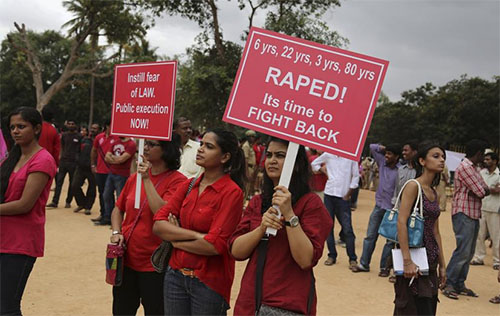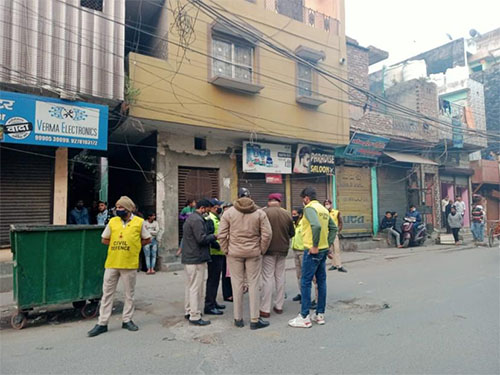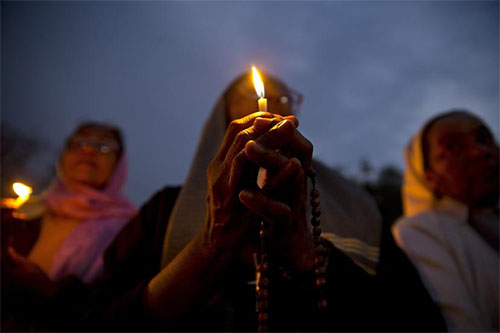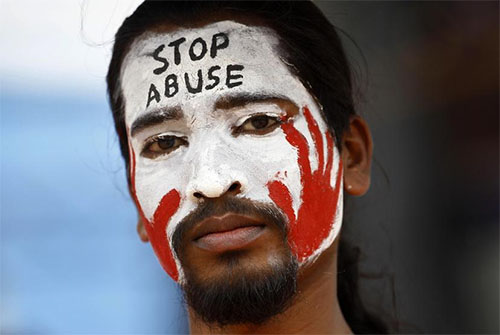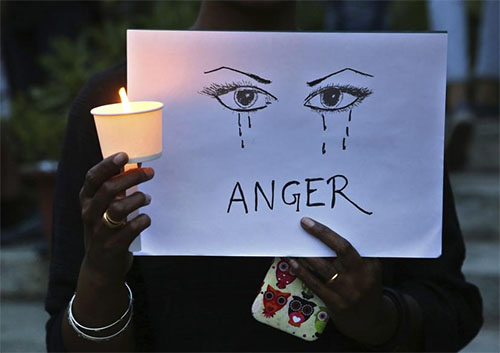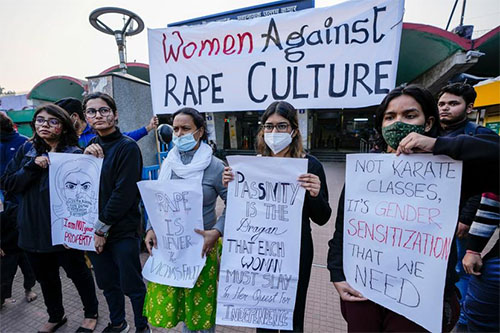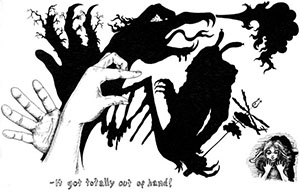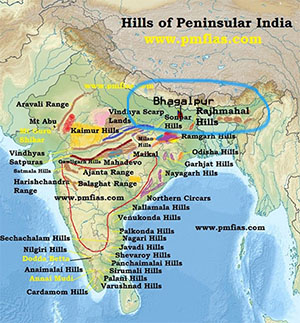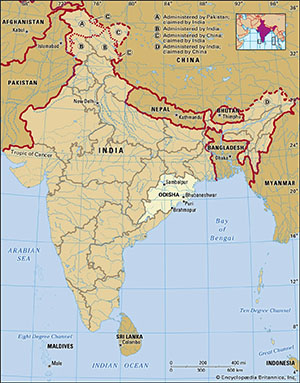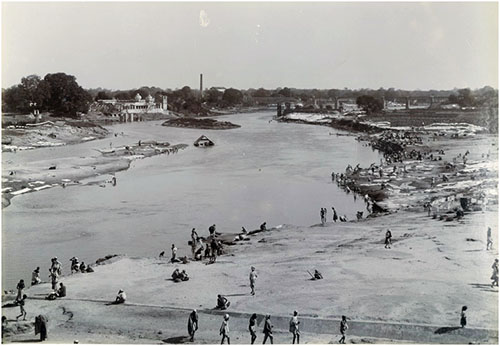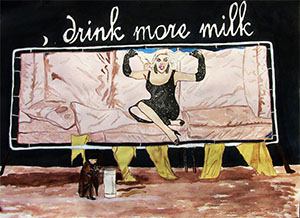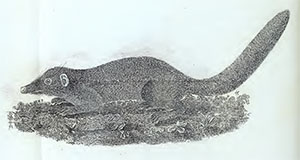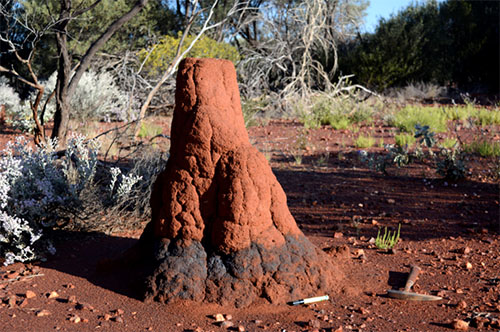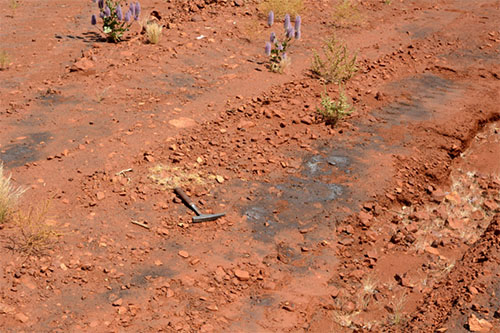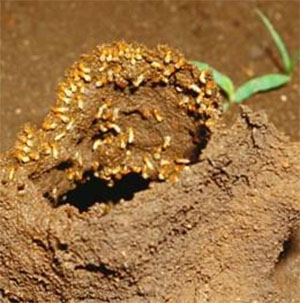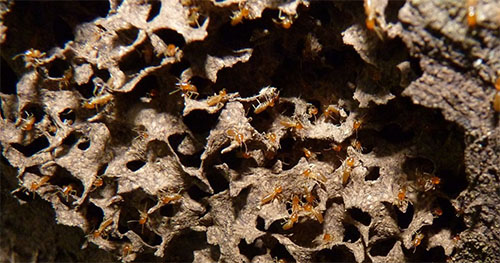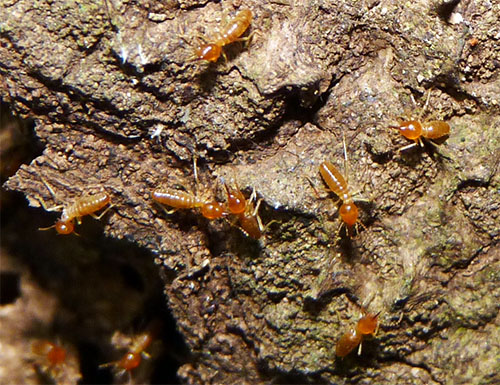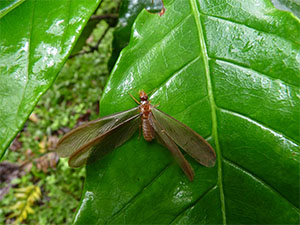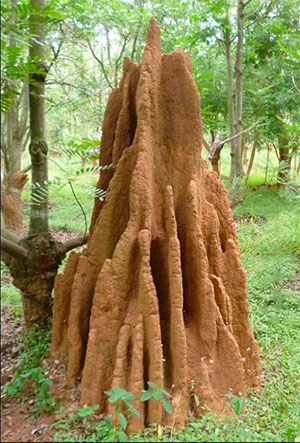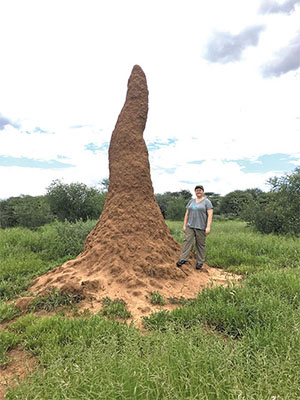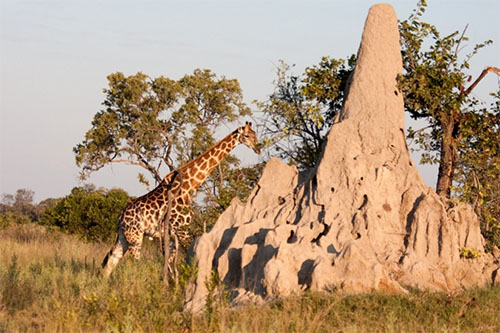Part 3 of 4
[Called "Damura/Dumbura" because the letter "M" easily admits "B" and "P;" declared to be Ptolemy's "Dorias" for "Domrias", which he places in a country south of "Salhala/Silhet", with two towns on its banks called "Pandass" and "Rangiberi," which latter is "Rangamati" near "Chatganh" in the country of "Reang"; near "Dumura/Chingree" is a town called "Reang;" "Rangamati/Ranga-bati" imply the same thing.] The next river is the Damura[???] or Dumbura[???], for the letter M easily admits B and P after it. In the lower part of its course it is called the Carmaphulli [Karnaphuli/Khawthlanguipui: Wiki], and falls into the sea at Chatganh; but Ptolemy has carried its mouth, and that of the Doanas, into the gulf of Siam....
Dumura is a very common name in India, and in the spoken dialects generally pronounced Dumri, Dumriya, Dumroy, &c. It is the river Dorias of Ptolemy, for Domrias. He has placed its source in some country to the south of Salhala or Silhet, and he mentions two towns on its banks: Pandassa in the upper part of its course but unknown; in the lower part Rangiberi, now Rangamati near Chatganh, and Reang is the name of the country on its banks. On the lesser Dumura, the river Chingree of the Bengal atlas, and near its source is a town called there Reang. Rangamati and Ranga-bati, to be pronounced Ranghari, imply nearly the same thing....
[Called "Pavani/Pavana/Pavaman/Pauman" because it flows through the country of "Pama-hang", called "Pummay" by Buchanan, which is why Portuguese writers called branch of "Cayan" river, "Cay-pumo", and Pliny called it "Pumas/Puman;" Sanscrit is "Pavana/Wind"; Cshetra-samasa calls it "Su-bhadra/the beautiful and great river", and "Brahmotari" river flows by "Mani-pura" to "Su-bhadra"; the "Pavani/Pauman/Su-bhadra" is the "Airavati" that flows by "Amara-pura"; the upper part of which Ptolemy calls "Serus", the lower part "Menan" flows by Siam; its Sanscrit word origin is obscure and not mentioned in any book.] The next river is the Pavani [the united stream of the Sarasvati and the Ghaggar, which is called by the name of Sarasvati, the most sacred river in ancient India: The Geographical Dictionary of Ancient & Medieval India, by Nundo Lal Dey, M.A., B.L., 2nd Edition, 1927] from Pavana, which in lexicons, as in the Amara-cosa, becomes in a derivative form Pavaman or Pauman. I believe it is so called because it flows through the country of Pama-hang* [Du Halde's China, Vol. 1st. p. 63.[???]] or Burma, which according to Dr. F. Buchanan is also called Pummay. Hence it is that the first Portuguese writers called one of the supposed branches of the Cayan river, flowing through the Burman country, Cay-pumo, and by Pliny it is called Pumas, or Puman. The Pauranics, as usual, searched for a Sanscrit origin for it, and derived it from Pavana, which signifies wind. In the Cshetra-samasa it is called Su-bhadra, or the beautiful and great river. The river Brahmotari, says the author, flows by Mani-pura, and going toward the east it falls into the Su-bhadra. The Pavani, or Pauman, called also Su-bhadra, is the Airavati, which flows by Amara-pura. It forms the upper or northern part of the river, which Ptolemy calls Serus, the lower part of which is the Menan which flows by Siam. The true spelling of the name of this river, and its Sanscrit origin, if derived from that language, are rather obscure, as it is not mentioned in any book that I have seen. I suspect, however, that it is hinted in the Garuda-purana, in a curious route performed by the souls of all those who die, at least in this part of the world. These souls, having assumed a pygmy form no bigger than the thumb, which is completed in twelve days after the decease, on the thirteenth, are seized by the servants of Yama and carried through the air to Yama-puri, or Yama-cota, on the high grounds in the center of the Malayan peninsula, and called Giam-cout (Jama-cota) by Muselman writers. There they remain one month, and thence go by land to Dharma-puri in the N.W. quarter of the world, on the shores of the western ocean, there to be judged by Yama with the countenance of the Dharma-Raja, or king of justice; for he has two countenances: one remains at Dharma-puri, and the other at Yama-puri. There are two roads: one for good men called Saumya, or beautiful, the other Cashtamarga, or the painful road: for now they travel on foot.
In fifteen days they reach Sauri-pur where rules Jangama with the dreadful countenance. When they see the town and its ruler they are much afraid, and there they eat the funeral repast of the third pacsha, or of the first month and half, offered by their sons.
Thence they proceed through dreadful forests to Varendra-nagara, where they eat the funeral oblation of the second month and receive some clothes, and then they set off for the next stage. The district of Varendra in Bengal, between Gauda and Dhacca, is well known.
Of the kingdom of Jangama we have some knowledge, and it is about half way between the Malayan peninsula and Varendra.[!!!] Its name is written Jangoma or Jangomay by European writers, and it is a great way to the north of Siam. It has the Laos to the east, and the country of Ava, or the Burman empire to the west. Its capital, Sauri, still unknown to us, is upon a river called I suppose after its name, Saura, or Sauri [???!!!].
Pavani: The river Ghaggar in Kurukshetra (district Ambala), or rather the united stream of the Sarasvati and the Ghaggar, which is called by the name of Sarasvati, the most sacred river in ancient India. The Pavani, which means the 'Purifier,' is said to be one of the eastern streams of the Ganges (Ramayana, Adi, ch. 43). Bharata crossed the river Sarasvati at its junction with the Ganges (Ibid, Ayodh., ch. 71). Whether the Sarasvati ever joined the Ganges or not, it is a fact that to the north of Thaneswar there is a celebrated Tirtha on the Sarasvati called Ganga-tirtha, where Ganga (the Ganges) is said to have bathed in order to get rid of her sins (Cunningham's Arch. S. Rep., 1863, p. 64; Panjab Gazetteer, Ambala District, p. 6, and the Ghaggar was a very important river before and the Sarasvati was its affluent instead of being the principal river itself as it is generally supposed (Panjab Gazetteer, Ambala District, ch. I, p. 5). 2. Same as Baidyanatha or Chitabhumi (Brihat-Siva P., pt. II, ch. 3).
-- The Geographical Dictionary of Ancient & Medieval India, by Nundo Lal Dey, M.A., B.L., 2nd Edition, 1927
[Laos' capital, "Sauri", is unknown to us, but must have been on a river also called "Saura/Sauri".]Siam. It has the Laos to the east, and the country of Ava, or the Burman empire to the west. Its capital, Sauri, still unknown to us, is upon a river called I suppose after its name, Saura, or Sauri....
[Ptolemy's town "Nardon" was in the country of "Rhandmarcota/the-fort-of-Randamar", which was also the name of the entire country; the Sanskrit name of the country is "Casara/Hedamba/Hidamba" whose king was killed by Bhim, who fell in love with his sister "Hidamba"; "Hidamba" was also called "Runda-munda," because he cut off the "Runda/head" of travellers and "Munda/threw it away"; Hindus greatly admire such a jingle of words; "Runda" was the name of every "Raja of Hedamba", so Bhima was called "Runda-mara/he-who-killed Runda"; "Dhundha-mara" killed "Daitya Dhundu"; "Runda-mara-cota" means "the fort of him who killed Runda"; "Runda" was also a "Daitya/Asura"; Pliny calls the river "Ava/Pumas/Puman", and nations in that country "Brachmanoe", which should be "Barmanoe."] Nardon is a town according to Ptolemy... situated in the country of Rhandamar-cota, literally, the fort of Randamar, after which the whole country was denominated...
The Sanscrit name of this country is Casara, and Hedamba or Hidamba, the king of which was killed by Bhim, who fell in love with his sister Hidamba, and remained with her a whole year. From this union are descended the present Rajas of that country who come occasionally to Benares to worship. Hidamba and his subjects were cannibals, and he and his sister wanted very much to eat Bhima as he was fat and plump. Hidamba was also called Runda-munda, because whenever he could catch any unfortunate traveller, he made his body Runda, or headless; and also he made his head Munda, that is to say, he cut it off and separated it from the body... Runda was the name of every Raja of Hedamba to the last who was killed by Bhima, who for that reason was, I believe, surnamed Runda-mara, or he who killed Runda: thus the famous king Dhundha-mara was so called, because he killed the Daitya Dhundhu. Runda-mara-cota signifies the fort of him who killed Runda. Runda was a Daitya [Asura], and a native of Sonit-pura, near Gwal-para, on the borders of Asama, and that place was the metropolis of the Daityas or devils, whilst the gods or followers of Brahma, lived to the westward of the Brahma-putra.[!!!] The country of the Daityas extended from that river eastward, to the banks of the Iravati, and was parcelled out amongst several chiefs; but he of Hedamba conquered them all... Pliny calls the river of Ava, Pumas or Puman, in the objective case; and says that many nations in that part of the country were called in general Brachmanoe, it should be Barmanoe. One is particularly noticed by him, "the Maccocalingoe, with two rivers called Pumas, and Cainas; both navigable, but the Cainas alone, says he, fall into the Ganges." It is therefore the Cayana, or Brahma-putra. The Maga-calingas are the Magas or Mugs, living near the sea shore in Chat'ganh, and Aracan.
[Ptolemy calls the easternmost branch of the Ganges "Antibole" in the country of "Airradon", which in Sanscrit is "Hradana", a name of the "Brahmaputra"; "Antibole" was also a town to the S.E. of "Dhacca" called "Fringy-bazar"; it is the "Antomela" of Pliny, which in Sanscrit is "Hasti-malla"; in the Swarodaya-mahatmya "Hasti-malla" is called "Hastibandh," because the Raja's elephants were quartered there; Pliny says it was at the confluence of five rivers, therefore it was called "Panchanada-nagara" in the Harivansa.] Ptolemy says that the easternmost branch of the Ganges was called Antibole[???] at Airradon. This last is from the Sanscrit Hradana, and is the name of the Brahma-putra. Antibole was the name of a town situated at the confluence of several large rivers to the S.E. of Dhacca, and now called Fringy-bazar. It is the Antomela of Pliny, and its Sanscrit name is Hasti-malla, in the spoken dialects Hathi-malla. In the Swarodaya-mahatmya[???], Hasti-malla, as well as the country about it, is called Hastibandh, because the elephants of the Raja were picketted there or in its vicinity. It was, says Pliny, situated at the confluence of five rivers, and on that account it is called Panchanada-nagara in the Harivansa....
The next is the Phani [Feni/Pheni Nadi: Wiki] or serpent river: it is mentioned in the Maha-bharat under the name of Airavat [Airavata is a mythological white elephant who carries the Hindu god Indra: Quora.], a large sort of serpent. On its banks lived the famous Ulupi, daughter of Airavat, or Pannaga, or the serpent king: from her and Arjuna, the Pandwan, are descended the present Rajas of Trai-pura or Camillah. This river is the Fenny of the maps....
[Called "Carma-phalli" because good Karma flourishes in it; "Chatgram" is called in the Puranas "Phulla-grama"; "Chatta/a-royal-mat-spread-under-a-tree"; "Patta/Pitha," with the addition of "Phulli," is "the blessing of a royal mat"; in the Scanda-purana "Patta/Chatta" are names of "Chatganh," but mean that when the Daitya Mahishasura was destroyed by the Devi, its bones and flesh appeared on the ground like large flagstones, or "Pattana" in Sanscrit, and "Chattana" in Hindi; the southern point at the mouth of the river is called "Pengui" because it is towards "Pengu/Pegu"; the northern point is called "Pattanh" which is the "Pente-polis" of Ptolemy, for "Patta/Pattan-phulli/the flourishing seat"; "Carma-phulli" is also rarely called "Carna-phulli", the "Carnabul/Chatganh" town of Edrissi because its situated on its banks; "Carma-phulli" in the upper part is called "Dumbura/Dumura/Dumriya", and when passing through the hills its called "Carma-phulli", but it's original name is "Bayuli/Bayula"; in the Bhuvana-cosa it is said to flow through the country of "Ari-rajya/Kingdom of Ari" where it is named "Nabhi/Naf/Teke-naf", and called "Hema/Golden" because it comes from golden mountains styled "Hema/Canchana/Canaca/Gold"; all rivers in this country are considered branches of the "Carma-phulli."] The Carma-phalli [Carnaphulli] [Karnaphuli: Wiki], or Chatganh[???] [in Chittagong???] river. It is mentioned in the Scanda-purana, in several Tantras, and Geographical Tracts. In the Bhuvana-cosa it is declared that it is so called because there Carma, or good works, do blossom and flourish most luxuriantly, so as to produce fruit most abundantly....
Chatgram [Chattagram/Karnaphuli River] is called in the Purunas Phulla-grama. Chatta is a royal mat spread under a tree in those times of simplicity of manners: Patta, or Pitha, any seat, with the addition of Phulli, implies a blessing to the royal mat, to the royal seat. This explanation of the meaning of Carma-phulli and Chatta-grama is in the Bhuvana-cosa....
In the Scanda-purana,* [Section of the bridge of Rama.] the words Patta and Chatta are acknowledged as the names of Chatganh, but with another meaning. Devi, having destroyed there, the Daitya Mahishasura; his bones, the flesh being rotten, appeared upon the ground like immense flag stones, or Pattana in Sanscrit, and Chattana in Hindi. The right, or southern point at the mouth of the river, is called Pengui because it is towards Pengu, or Pegu; the left, or northern point, on the side on which the town is situated, is called to this day Pattanh. There can hardly be any doubt, in my humble opinion, but that this town is the Pente-polis of Ptolemy, for Patta, or Pattan-phulli, the flourishing seat.
The Carma-phulli is also called, though rarely, Carna-phulli, and it is the Carnabul of the Edrissi, who wrote about the year 1194: but that geographer has bestowed that name rather upon the town of Chatganh, because situated on its banks....
The Carma-phulli, as I observed before, is called in the upper part of its course Dumbura, Dumura, or Dumriya: on its passing through the hills it assumes the name of Carma-phulli: but its original name is Bayuli or Bayula.* [Cshetra-samasa and Bhuvana-cosa.] In the Bhuvana-cosa it is declared that it flows through the country of Ari-rajya, or kingdom of Ari, where it assumes the name of Nabhi, according to the Cshetra-samasa, and is commonly called the Naf, and Teke-naf. This river is called in the Bhuvana-cosa, Hema, or golden river, probably because it comes from the golden mountains, styled Hema, Canchana, Canaca &c., which signify gold. In general all the rivers of this country are considered as branches of the Carma-phulli, some are actually so, others are so only in a mystical sense....
[The "Rajju" river in Sanscrit means "rope/bamboo" and is synonymous with "Guna/Dama"; there the king Naraca placed the "Linga/Phala" of Maha-deva, called "Adya-natha/Adi-natha/Linga/Phallus"; another name for it was "Phalgunagar/town of Phalguna/built-by-Arjuna"; also called "Pharwagara;" it is the "Baracura" of Ptolemy; also called "Phalgun/Palong/Palong-Burra."] The river we mentioned before, two Yojanas to the south of Ramu, is called Rajju[???], which in Sanscrit signifies both a rope and a bamboo. Rajju is also synonymous with Guna and Dama; which last is the name of several places on that coast. Perhaps these words imply that there was either a cable, or a boom of bamboos lashed together, laid across the river. There the king of Sonitpur, Naraca, placed the Linga, or Phala of Maha-deva, under the name of Adya-natha, or Adi-natha, the primeval lord, Linga and Phallus. In the Bhuvana-cosa, it is said, that this place was laid waste by the Yavanas, or Muselmans. Another name for it was Phalgunagar, or town of Phalguna, having been built by Arjuna, called also Phalguna. In the Cshetra-samasa it is said that it was near a river, and that it was built by a man of that name, and it is, says our author, commonly called Phanguna or Phalgun. Another name for it, he adds, is Pharwagara, and this, in my opinion, is the Baracura of Ptolemy. Phalgun is called Palong in the maps, with the epithet of Burra, or the great, which might have been the case formerly....
[Called "Nabhi/Naf" because it comes from "the navel of a god who lives in the hills"; called "Teke-naf" because it flows through the country of "Teke/Tecu/Teceu;" sometimes called "Dombac" from a country on its banks; the Sanskrit name of "Aracan" is "Barma/Barman/Barmanaca;" by the people of "Pegu" it is called "Takain"; Buchanan says the "Thoek" tribe lives on the river "Naaf," and sent a colony to the upper parts of the "Carna-fulli"; in the Cshetra-samasa it is called "Carcandu/Cacundi" in the country of "Cemuca/Ceu/Ceunca," and its inhabitants are called "Ceuci/Kookies;" a respectable native said that at "Aracan" the inhabitants were from the tribe "Tek/Teke," and the country was called "Tekain/Takain/Tecain/Yecain/Recain"; Buchanan says indistinct articulation is fashionable through Burma and other countries.] To the south of the Rajjoo, about forty miles, is the river Nabhi [Naf: Wiki], vulgarly Naf, because it proceeds from the navel of a certain god, who resides amongst the hills. It is more generally called Teke-naf, and in official reports made to Government I understand that it is generally so called. Teke-naf implies that it flows through the country of Teke, written in some Sanscrit books Tecu, and Teceu, to be pronounced Tecoo and Tekyou....
In some maps it is called the Dombac river, from a place of that name situated on its banks. The Sanscrit name of Aracan is Barma, Barman, and Barmanaca proper; by the people of Pegu it is called Takain. Dr. F. Buchanan* [Asiatick Researches, Vol. VI. p. 229.] says that Thoek is the name of a tribe living on the eastern branch of the river Naaf, and who sent a colony to the upper parts of the Carna-fulli; and this circumstance is recorded in the Bhuvana-cosa in these words: "at Carcandaca, in the woods, will come a Tecu-raja, who will abolish all distinctions of casts; but Nagarjuna will destroy him." In the Cshetra-samasa it is called Carcandu, near the Carma-phulli, and its present name is Cacundi, says our author. It is also in the country of Cemuca, commonly called Ceu or Ceunca, and its inhabitants Ceuci or Kookies. A respectable native of Rangoon who came some years ago to Benares with many persons of that country informed me that he had been at Aracan, and that he understood that the bulk of the inhabitants were of a tribe called Tek or Teke, and from it the country was called Tekain or Takain. He suspected that Tecain, Yecain and Recain, might be the same name differently pronounced, and indeed Dr. Buchanan says that indistinct articulation is fashionable through the Burman empire and the adjacent countries....
[Called "Mahanadi/great-river"; Ptolemy calls the "Mahanadi" river "Tocosanna"; the "Tekeu" tribe is in the country of "Teke-naf/Takain;" the town of "Aracan" is called "a stone city" because it's surrounded by rocks cut artificially like fortifications; another name for "Aracan" is "Rau-shan" and the tribes in that country are called "Ru/Yu/Rai/Yai"; but the meaning of "shan" is unknown; Portuguese writers mention a country called "Co-Dowascan" which is "Cu-Tecwa-shan," alluding to the invasion of the "Cu/Cuci" country by the "Thoeke" tribe; to the Portuguese, "Towascan" is the name of a town, which is really "Aracan", the city of the "Teke-shan" tribes; Ptolemy puts a town on the "Tocosanna" called "Tri-lingon," which is Sanskrit, and also "Tri-glypton," which is an attempt to render into Greek the meaning of "Tri-linga/Trai-linga/the three lingas of Maha-deva," of which the "Tri-sul/trident" is the emblem; rendering it with three perpendicular cuts parallel to each other is called "Tri-glypton" in Greek; in the Puranas, "Aracan" is part of a larger district called "Tri-pura/Trai-pura".] The next river is the Maha-nadi [Mahanadi: Wiki], or great river, which flows by Aracan. There is Sila or Saila-pattuna, or the stone city, the seat or throne of the Maga Rajas. There in the Maha-nadi is Venu-gartta, or the bamboo fort; but the sea overflowing will destroy it, and leave in many places shoals, and sand banks. This is the second inundation of the sea, which will do so much mischief to the whole country. The first, it appears from our author, affected chiefly the shores of Chatganh. This bamboo fort, I suppose, has been rebuilt more inland, for it still exists and is mentioned in a French map by the Sr. Robert in the year 1751, where it is called Fort de Bamboux. In a sketch of the mouth of the river of Aracan by D’Anville it is inserted, but without a name. It is placed there about sixteen miles to N.E. of the pagoda, at the entrance of the river on the left side.
Venugartta is literally a bamboo pit in Sanscrit, but in Hindi it is either Venu-gar or Venu-gara: the first signifies a bamboo fort; the second a bamboo-pit, which last is hardly admissible. The town of Aracan may be called with great propriety the stone city, being surrounded by steep craggy rocks, cut artificially like fortifications....
The Aracan river, in the Bhuvan-cosa, is called Maha-nadi, or the great river; but its real name among the natives is unknown. Ptolemy calls it Tocosanna, the true pronunciation of which is, I believe Teku-shan or Teke-shan, and we have in that country the Teke-naf: the inhabitants of Aracan are of the Tekeu tribe, and the country is called Takain, and the word shan is certainly obvious in Rau-shan, another name for Aracan, and I believe that Ru or Yu, Rai, Yai, are the names of a tribe in that country, for, says Dr. Buchanan, what is written Roe is pronounced Yoe in that country.... It appears to me that Teku-shan was pronounced by the Portuguese Touascan, for Teke-shan, or Tecwa-shan, in a derivative form from Tecu-shan. Portuguese writers mention also another district called Co-Dowascan, which I suppose to be Cu-Tecwa-shan, and to allude to the invasion of the Cu, or Cuci country, by the Thoeke tribe, as mentioned by Dr. Buchanan....
With Portuguese writers Towascan is not the name of a river but of a town, which I conceive is no other than Aracan, the metropolis of the Teke-shan tribes. Ptolemy places on the Tocosanna the metropolis of the country, and calls it Tri-lingon, a true Sanscrit appellation. Another name for it, says our author, was Tri-glypton, which is an attempt to render into Greek the meaning of Tri-linga or Trai-linga, the three Lingas of Maha-deva, and of which the Tri-sul, or trident, is the emblem....
It is often represented by three perpendicular cuts parallel to each other, and this, in Greek, is called Tri-glypton. Aracan is part of an extensive district called Tri-pura, or Trai-pura in the Puranas, or the three towns and townships first inhabited by three Daityas, the maternal uncles of Ravana. These three districts were Camilla, Chattala and Barmanaca, or Rasang, to be pronounced Ra-shanh, or nearly so; it is now Aracan. Maha-deva destroyed these three giants and fixed his Tri-sul in Camilla, which alone retains the name of Tripura...
Ptolemy says that in the country of Tri-linga, there were white ravens, white parrots, and bearded cocks....
["Sandowy/Thayndwa/Saindwa" is the southernmost division of "Aracan"; in the Bhuvana-cosa it is called "Sandwipa" which should be instead "Sandwi"; in that place is a river and town called "Sedoa/Saindwa" and by Ptolemy "Sadus/Sada"; between this river and "Aracan" is another large river called "Cata-baida/Cata-baiza"; this is Ptolemy's "Catar-beda" river, which he erroneously places to the north of "Aracan"; "Cata" is a "fort", and "Byeitza/Baidza" is the name of a tribe in that country"; the island of "Cheduba" across the river is called "Bazacata" by Ptolemy; Buchanan says that the letters "T", "D", "Th", and "S", "Z" are used indiscriminately in that country, and also indistinct pronunciation is fashionable.] The Maha-nadi, or river of Aracan, is the last on that coast in our Sanscrit records, and the district of Sandowy, called also Thayndwa or Saindwa by Dr. Buchanan, and declared by him and* [Asiatick Researches, Vol. 6th. 199 and 201.] Captain Symes, to be the southernmost division of Aracan, is also the most southerly district of the empire of the followers of Brahma, or India, along that coast, ending in about eighteen degrees of latitude north. In the Bhuvana-cosa it is called Sandwipa, but I believe it should be Sandwi. In that district is a river and a town, called in modern maps, Sedoa for Saindwa, and in Ptolemy Sadus and Sada. Between this river and Aracan there is another large one, concealed behind the island of Cheduba, and the name of which is Cata-baida, or Cata-baiza. This is the river Catar-beda of Ptolemy, which, it is true, he has placed erroneously to the north of Aracan; but, as it retains its name to this day among the natives, and as it is an uncommon one in that country, we can hardly be mistaken....
In the language of that county, Cata is a fort, and Byeitza, or Baidza, is the name of a tribe in that country...
The island of Cheduba, opposite to this river, is called very properly Bazacata by Ptolemy, and Dr. Buchanan informs us that the letters T, D, Th, and S, Z, are almost used indiscriminately in that country, where even indistinct pronunciation is fashionable.
[Hindus say that all ledges of rocks and islands placed in a line, are the remains of bridges made by gods or devils.] In the countries of Chattala and Barmanaca, Rama-chandra began his first bridge in his intended expedition against Ravana. The abutment took up the whole of these countries; and then Rama-chandra carried on his works directly towards Subela, or Sumatra, and had nearly reached that island when, by the advice of Vibhishan, king of that country, he left off and began another bridge at Rameswara, in the south of India. Of the former bridge seven piers are still to be seen which form the archipelagos of the Andaman and Nicobar islands, exhibiting vast ruins consisting of all the rocks which surrounded them. The Hindus fancy that all ledges of rocks, and all islands placed in a line, are the remains of bridges made either by the gods or by the devils, for some particular purposes, generally unknown to us at present.
[The bay of "Cruzcool" has a river that falls into it called "Mushcolley," which is also the name of the island opposite, called "Mascal" by the sea people; the name of the island to the north is called "Cuccura-dwipa/Island of dogs;" "Cuta" = "dog"; "Cuttub-dea" comes from "Cuta-dwip," which has a place in it called "Cukera-hansera/Dog-swimming-creek"; called "Quoqor-diva" by Lindschot, and "Cuccuri-diva" by Monserrat.] The Portuguese maps exhibit only four rivers on that coast: that of Chatganh; the Chocoria, to be pronounced Khocoria; the river and gulf of Rameu; and the river of Aracan. The gulf of Ramu, now called the bay of Cruzcool, has a considerable river that falls into it called Mushcolley, after which is denominated the opposite island, but called by our seafaring people Mascal, this appellation being more familiar to them; but in the Portuguese maps there is no name affixed to it. The name of the island to the north of this is Cuccura-dwipa, but in the spoken dialects Cuccur-diva, or Cuccur-dia, or the island of dogs. In these dialects a dog is generally called Cuta; and from Cuta-dwip I suspect they have made Cuttub-dea. There is a place in it called Cukera-hansera, which, the pilots say, signifies Dog-swimming Creek. It is called Quoqor-diva by Lindschot in his map of India, and Cuccuri-diva by F. Monserrat.* [In an autograph MS. of the author, in my possession. The Padre wrote about the year 1590 in the prisons of Senna in Arabia.]
[The source of the Ganges is a basin called "Cunda", the shape of a drinking vessel in Sanscrit; called "Piyali" in Hindi; below is a fall with a rock in the middle called "Patacni/Patcani/the-head-of-the-Linga-of-Mahadeva" which the Ganges tumbles over; the river then goes to "Awartta/ Hara/ Hari/ Brahma/ Gangawartta/ Brahmawartta/ Haradwara/ The-gate-of-Hara"; "Awartta" is an enclosed circular place; the Pauranics say the Ganges flies over the mountains and falls into the "Cunda" of "Brahma" which is Lake Manasarovara; and thence to another "head-of-Mahadeva", from which it drops into a basin called "Bindu-sarovara".] The source of the Ganges is supposed to be in a basin called Cunda, because it is in the shape of a drinking vessel so called in Sanscrit, and Piyala in Hindi... and the water, forcing its way at the bottom, re-appeared at a considerable distance through subterraneous channels.
This is supposed to be the case with our Cunda, which is said to be deep, and that water is constantly oozing and dripping from its steep and guttered sides, forming many little streams which are called the hundred weepers from the manner in which they fall, and also from the noise they make. These falling to the bottom form a considerable stream, which they say forces its way through channels, either under ground or under the glaciere... This stream re-appears at Gangautri, where is a fall of no great magnitude. Below the fall, in the middle of the river, is a rock styled the head, or top, of the Linga of Maha-deva. The Ganges tumbles over it, hence this stone is called, from that circumstance, Patacni, or Patcani. From thence the river goes to the Awartta of the Ganges, or of Hara, Hari, and Brahma; and thus we have Gangawartta, Brahmawartta, &c.; but it is more generally called Hara-dwara, the gate or pass of Hara. Awartta literally signifies an enclosed place of a circular form...
The Pauranics declare that the Ganges, issuing from under the feet of Vishnu under the pole, flies through the air, brushing the summits of the highest mountains, and falls into the Cunda of Brahma, which is acknowledged to be the lake of Mana-sarovara, and from thence through the air again it alights upon the head of Maha-deva, and remains entangled in the lock of hair on his head, from which it drops continually into a bason beneath called Bindu-sarovara, or the dripping pool...
[Branches of the river are called "Buri-Ganga/Old Ganges" by the country people, because when the Ganges moves away from its old bed, it gets overrun with "Bana/reeds/thickets", in Sanscrit called "Saraban"; also called "Saravati/Abounding-with-reeds," and called "Rama-ganga" to the east; a branch that springs out at Hardwar and rejoins the Ganges at "Banghatt" is also called "Ban/Saraban" and the present bed to the east was once called "Ban/Saraban"; Ptolemy mistook this for the "Rama-ganga," also called "Ban/Saraban/Saravati"; the four towns he places on its banks are "Storna/Hastnaura", "Sapotus/Hastina-nagara", "Sabal/Sabulgur", and "Eorta/Awartta"; called "Arate" in the Peuting tables.] These branches have various names, but in general they are called by the country people Buri-Ganga, or the old Ganges. Another name is Ban-ganga, or the reed river, because, whenever the Ganges, or any other river forsakes its old bed, this old bed and its banks are soon overrun with Bana, or reeds, which form numberless thickets, in Sanscrit Saraban; and these two denominations are used by the learned, particularly the latter.
It is by no means an uncommon name in India, as well as Saravati, or abounding with reeds. It has also the name of the Rama-ganga, to the eastward of the Ganges.
The only branch of that name, which can attract our notice, is to the westward, springs out at Hardwar, and rejoins the Ganges at Banghatt. This part is well delineated in the general map of India. It springs out again, according to the late surveys, at Succur-taul, passes to the eastward of the ruins of Hastina-pur, and rejoins the Ganges at Gur-mucteswar. This Ban, or Saraban river, was formerly the bed of the Ganges, and the present bed to the eastward was also once the Ban or Saraban river.
[At two declivities in the Gangetic plains the Ganges strikes against "Padanta/ Padantica" which are "the foot's end of the mountains"; this female deity's restless disposition is checked by the "Padanti/foot-of-the-mountains".] In the immense plains of Anu-Gangam, or the Gangetic provinces, there are two declivities or descents. One towards the east, and the other from the northern mountains towards the south. This precipitates the waters of the Ganges against its right bank, towards the south, and makes them strike with violence against the Padanta, or Padantica, the foot’s end of the mountains to the south, and which begins at Chunar and ends at Raj-mahl....In the upper parts of the course of the Ganges, as far down as the pass of Sancrigali, its aberrations and wanderings are confined within narrow limits, and its encroachments and devastations are comparatively trifling. It is a female deity, and in her watery form is of a most restless disposition, seemingly bent on mischief, and often doing much harm. This unrelenting disposition of hers to encroach is greatly impeded, and checked, by the Padanti, or the foot of the mountains, with its rocky points projecting into the stream such as Chunar, Mudgir, Sultan-gunge, Pattergotta, Pointy, Sancri-gali, and Raj-mahl.
The word Padanti is pronounced Ponty in the spoken dialects, and is spelt Paentee by Dr. Hunter, in his Dictionary. But by Pointy we generally understand now that rocky point, which is near Patter-gotta.
["Chunar" in Sanscrit is "Charanadri/Charana-giri," which is synonymous with "Pedantica"; in the Ratna-cosa and Puranas it is called "Padapa".] The Sanscrit name of Chunar is Charanadri, or Charana-giri, which is nearly synonymous with Padantica. This last is mentioned in the Ratna-cosa, and in some Puranas, where it is called Padapa.
[But the Ganges is hard to control, and still she carries away the hills of Chunar and Mudgir.] Between these huge rocky points the Ganges is constantly at work, excavating deep bays and gulfs, which, after long periods, she fills up entirely, and then scoops them out again. Even the huge rocky points I just mentioned, have by no means escaped her unrelenting activity. They are cut down almost perpendicularly from top to bottom; and it is written in the Purunas, that the Ganges has carried away the half of the hills of Chunar, and Mudgir...
[Because the Ganges is a deity, the sacred number "three" is applied to it: it comes down from heaven in a threefold stream which forms a "Triveni/three-plaited-locks": the second "Triveni" is the Prayag meeting the Yamuna and Saraswati; and the third "Triveni" are the two rivers at Hoogly.] As the Ganges is a most favourite deity of the Hindus, they have in various shapes applied to it the ineffable and mysterious number THREE, the type of the Hindi triad. It comes down from heaven in a threefold stream, which upon earth forms a Triveni, or three plaited locks. This stream at Prayag, meeting Yamuna and Saraswati, forms here a second Triveni, and the two last rivers near Hoogly, forsaking the Ganges, form a third Triveni....
[Inferior rapids are called "Patacni/Patcni/Patcanya" by natives, called by the poets "Nirvana-vaha/rapid-of-the-departed," because they are dangerous.] There are several inferior rapids in the Ganges which are called by the natives Patacni, Patcni, and Patcanya. The last Gangautri begins at Patter-gotta, and ends at Sancri-gali, and is certainly a dangerous rapid where many accidents happen....
Hence I am told that poets sometimes called it the reach, stream, or rapid of the blessed or departed, Nirvana-vaha...
[The "Pointy/rocky point" is called "Sancri-gali" from Sanskrit "Sancirna-gali/intricate, narrow pass".] There were also three remarkable Charanadris, or Padantis [rocky point]: Chunar, Mudgir and Pointy, each of which had a Gala, Gali, a pass, or Gully. The last is called Sancri-gali, from the Sanscrit Sancirna-gali, or the intricate and narrow pass....
[Ptolemy names five mouths of the lower Ganges flowing into the sea: (1) "Cambuson", (2) "Bhagirathi", called in Sanskrit "Vriddhamanteswara-Samudra/Swelling-Lord-Oceanus" alluding to the Bore which appears in the river; it begins at "Fulta"; in Sanscrit "Phulla-gram", called this because "Samudra swells with joy at the sight of his beloved son Lunus, and his heart like a flower opens at the sight of him"; "Vriddhamanta" means "increase," it is called in the spoken dialects "Buddmanteswara/Manteswari"; it forms three channels formed by sand banks; the "Ragi-masana" is called "Misen-sand" by the sea people, "Ragi" means "lusting after", and "Masuna" comes from Sanscrit "Masi" which means "changing form"; but "Masan," in the spoken dialects, when speaking of the Ganges, describes a part of the channel that looks like "gentle boiling water with sand rising up and down" due to the quicksand there; the "Ragi-masana" is also called "Ran-masan", "Rana" means "tumultuous struggle"; this second mouth, because of its size and the Bore in it, is called "Samudra/Oceanus", "Sagara/Pontus", "Narayena/Nereus/Nereon" and "Varuna/ Naupati/ Naupatin/lord-of-ships/Neptune/Nephtyn; this is the "Ostium magnum" according to Ptolemy; the third mouth is called by Ptolemy "Camberikhon" which is the river "Cambaraca," in Sanscrit "Cumaraca", called in the spoken dialects "Cambadac/Cabbadac," and by early writers "Gundruc/Gumbruc" and "Gaudet" which is a mistake, as this is "Godupa/Godui/Godavahi/Gorroy" to the east of "Bhushna"; the "Cumaraca" and "Ichhamati" are branches of the "Bhairava/Boyrub/proceeding from the sweat of Maha-deva"; the fourth mouth is called "False" by Ptolemy due to its being mistaken for the easternmost branch of the Ganges which is hidden behind islands; its Sanscrit name is "Trina-cachha" according to Davi-Rama's commentary, because its banks are "covered with grass" and abound with "Harina/deers/antelopes" for which reason it is also "Harina-ghatta", because the animals appear at the "Ghatts/landing places".] Let us now pass to the lower parts of the Ganges, in its course towards the sea through the Antarvedi, or Delta of the Ganges. Ptolemy reckons five mouths...
The first mouth is the Cambuson, now the Suvarna-recha, or Pipley river...
The next or second mouth, which is that of the Bhagirathi, is called in Sanscrit Vriddhamanteswara-Samudra, literally the swelling lord Oceanus, alluding to the [wild] Bore which makes its appearance in this branch of the river. It begins at Fulta, and reaches sometimes as far as Nadiya. Phulla-gram is the Sanscrit name of Fulta, and is so called because Sumudra swells with joy at the sight of his beloved son Lunus, and his heart, like a flower, opens and expands at the sight of him. Vriddhamanta implies increase, either in bulk, consequence, or wealth, &c. In the spoken dialects it is called the Buddmanteswara, and simply the Manteswari river. It is said in the Cshetra-samasa to consist of three channels... These channels are formed by sand banks, denominated in some places braces, and in others reefs and flats. The Ragi-masana is along that sand, corruptly called by seafaring people the mizen-sand, Ragi signifies lusting after, greediness of prey. Masuna is supposed to be derived from the Sanscrit Masi, which signifies a change of form: but Masan in the spoken dialects, when speaking of the water of the Ganges, implies a particular part of the channel where the stream puts on a new form, and which looks like a gentle boiling of the water with sand rising up and falling down. That part of the Channel is carefully avoided by boatmen, as it shews that there is a quicksand which causes this appearance. I am assured that it is also called Ran-masan, nay some insist that this is the true reading. Rana implies a tumultuous struggling attended with a quick motion and running, and answers here to the English word race, as used by seafaring people.
This mouth is thus called on account of its size, and of the tremendous appearance of the Bore in it, Samudra is Oceanus, Sagara is Pontus, Narayena is Nereus or Nereon, and Varuna, called also Naupati, or Naupatin, or the lord of ships, is Neptune, and perhaps the Nephtyn of the Egyptians. This is the Ostium magnum, the second mouth of the Ganges, according to Ptolemy.
The third mouth, called by him Camberikhon, is that of the river Cambaraca, the true Sanscrit name of which is Cumaraca according to the Cshetra-samasa....
The fourth is called the false mouth by Ptolemy, probably because it is so broad and extensive, that it was often mistaken for the easternmost branch of the Ganges which lies concealed behind numerous islands. Its Sanscrit name, according to Cavi-Rama’s Commentary[???], is Trina-cachha, on account of its banks being covered with luxuriant grass, and of course abounding with Harina, deers, and antelopes, for which reason it is also called Harina-ghatta from their frequently making their appearance at the landing places, or Ghatts....
[The second mouth, "Bhagirathi", sends a branch to the west and another to the east at "Tri-veni," because three rivers part in three different directions; the branch to the west is the famous "Saraswati", and Ptolemy says it flows into the first mouth, the "Cambusan", and [wrongly] the mouth of the "Jellasore", called in Sanscrit "Sactimati," which is synonymous with "Cambu/Cambuj/river-of-shells" which sends another branch into the second mouth, the "Bhagirathi", and is called "Rupanarayana"; the branch to the east goes into the third mouth, the "Cambarican", and is the "Jumna/Jubuna"; the "Jumna" and "Saraswati" unite at the northern Triveni, "Allahabad", and part at the "Triveni" near "Hoogly", called "Tropina" by Pliny, and "Trippini/Terboni" by the Portuguese; "Jumna" gets its name from "Cambadaca/Cambarac"; Ptolemy says the Ganges sends an arm to the east to the fourth mouth, the "false" mouth or "Harinaghatta", and from this springs another branch to "Antiboli," which is the "Dhacca" branch called "Padma/Pudda-ganga", which sends an arm into the "Harina-ghatta" near "Custee/Comercolly," and flows into the "Harina-ghatta" mouth.] Ptolemy’s description of the Delta is by no means a bad one if we reject the longitudes and latitudes, as I always do, and adhere solely to his narrative, which is plain enough. He begins with the western branch of the Ganges, or Bhagirathi, and say, that it sends one branch to the right, or towards the west, and another towards the east, or to the left. This takes place at Tri-veni, so called from three rivers parting in three different directions, and it is a most sacred place. The branch which goes towards the right is the famous Saraswati, and Ptolemy says that it flows into the Cambusan mouth, or the mouth of the Jellasore river, called in Sanscrit Sactimati, synonimous with Cambu, or Cambuj, or the river of shells. This communication does not exist, but it was believed to exist, till the country was surveyed....
The river, which according to Ptolemy, branches out towards the east, or to the left, and goes into the Cambarican mouth, is the Jumna, called in Bengal Jubuna. For the Ganges, the Jumna and the Saraswati unite at the northern Triveni, or Allahabad, and part afterwards at this Triveni near Hoogly. It was known to the ancients, for it is called Tropina by Pliny, and by the Portuguese Trippini, and in the spoken dialects they say Terboni. Though the Jumna flows into the Camberican mouth it does by no means form it, for it obviously derives its name from the Cambadaca, or Cambarac river, as I observed before. But let us proceed: Ptolemy says that the Ganges sends an arm toward the east, or to the left, directly to the false mouth or Harinaghatta. From this springs another branch to Antiboli, which of course is the Dhacca branch, called the Padma, or Pudda-ganga. There is a mistake, but of no great consequence, as the outlines remain the same. It is the Padda or Dhacca branch, which sends an arm into the Harina-ghatta. The branching out is near Custee, and Comercolly, and under various appellations it goes into the Harina-ghatta mouth....
[The natives in the country near the western boundary of "Anuganga" say the "Setlej" ran into the "Caggar/Drishadvati" forming a river called "Dhutpapa" in Sanskrit, and "Tutapus" by Megasthenes; the "Caggar" was considered by ancient writers to be the boundary of the excursions of the gold-making ants."] It was my intention to have described the western boundary of Anugangam [Ganges: Wiki] in the same manner as I have described the others, but I find it impossible, at least for the present. A description of the country on both sides of the said boundary would certainly prove very interesting, but the chief difficulty is that the natives of these countries insist that the Setlej [Sutlej: Wiki] formerly ran into the Caggar, or Drishadvati, and formed a large river called in Sanscrit Dhutpapa, and by Megasthenes Tutapus....
As the Caggar, or some river falling into it, is supposed by our ancient writers to have been also the boundary of the excursions of the gold making ants toward the east, I shall give an account of them, as possibly I may not have hereafter an opportunity of resuming the subject; the legends are certainly puerile and absurd, but as they occupy a prominent place in the writings of the naturalists and geographers of classical antiquity, they may be regarded as worthy of our attention, and it may at least be considered as a not uninteresting enquiry to endeavour to ascertain their source.
